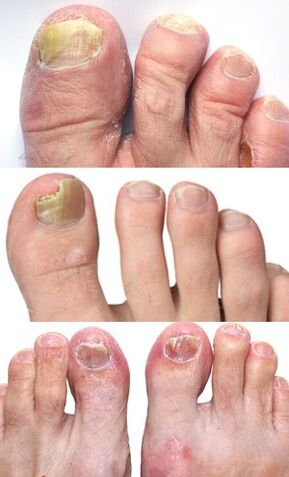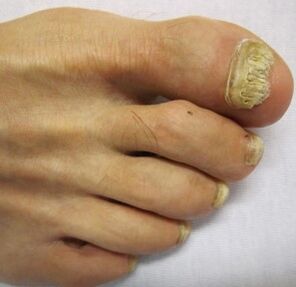The fungus damages part and all of the nail, including the nail, bed, and the base of the nail. The infection develops slowly, causing the nail to discolor, thicken, and bend. Attached signs may include finger lesions, peeling, itching, and redness. Over time, the nails become so deformed that they interfere with the normal wearing of shoes.
Most often, the fungus affects the toenails. The medical name is onychomycosis. It is mainly seen in the elderly and rarely in children. In most cases, onychomycosis develops under the influence of the fungus dermatophyte, which also affects the skin. Sometimes it is caused by other fungi.
In mild cases, nail treatment may not be necessary. To accurately identify the cause of the infection and rule out other possible diseases, a dermatologist will analyze the cut nail. Nail fungus can be cured, but sometimes it takes months. Antifungal medications come in the form of oral pills and nail polish. In the case of onychomycosis, they have to surgically remove the nail. There are also laser treatments.
Signs and symptoms of nail fungus
The most common symptom of onychomycosis is discoloration and deformity of the nail. Nails can turn white, black, yellow, or green. As a rule, nail fungus is not worrisome at first and in most cases there are no complications. If the infection is left untreated, you may experience pain in the damaged nail. Toenail fungus makes it difficult to walk and wear shoes, and if the nail is affected, it can make it difficult to write.
As onychomycosis develops, other symptoms appear, such as the nail may become brittle, loose or completely peel off the nail bed. If left untreated, the fungal infection can spread to the skin of the fingers and between the fingers. White or yellow spots may appear on the foundation and the skin around the nail may peel off. All of these changes can be seen in the photo on nail fungus.
Causes of nail fungus

The most common cause of toenail damage is a fungal skin infection, such as foot fungus. Usually, foot fungus develops on the skin between the toes, causing it to turn red, flaky, and itchy. Fungi grow and multiply quickly in warm, humid environments, so wearing sneakers or sweating for long periods of time increases the chances of an infection. About one third of people suffer from rot fungus on the feet and fingernails.
Toenail fungus can be caused by a candida infection, which is also the culprit of conditions like vaginal yeast or stomatitis. The chance of getting nail fungus is higher if at work one has to wash their hands often or stay in water for long periods of time. Moisture exfoliates the skin at the base of the nail, making it easier for fungus to penetrate the nail. The risk of developing candida nail damage is higher with certain diseases, namely:
- diabetes or psoriasis;
- weakened immunity, for example, to HIV;
- poor general health.
Other factors that may increase your risk of developing nail fungus include:
- wearing fake nails;
- damage to the nails;
- nail biting repeatedly;
- live in a warm, humid climate;
- smoke.
With age, the likelihood of getting nail fungus increases. Sometimes fungi show up for no apparent reason.
Treat nail fungus
In mild cases, treatment may not be needed. However, if left untreated, the infection can spread to other nails and the skin of your toes and hands. To get rid of onychomycosis as soon as possible, it is important to follow simple rules: give up shoes with sweaty feet, trim nails and carefully monitor foot hygiene.
When using the drug, a new, healthy nail will begin to grow in the base of the nail, indicating that the treatment is working. The affected old nail will gradually regrow and can be trimmed within a few months. If after 2-3 weeks of treatment, new nails do not begin to grow, you should consult your doctor. It is not possible to stop using prescription drugs without consulting a doctor, as this could lead to infection returning.
Foot care tips for toenail fungus
Here are tips on how to prevent infection during and after treatment.
- keep feet dry and cool, wear socks and shoes to "breathe";
- Wear clean cotton socks and try to wear sneakers as little as possible;
- initiate treatment for foot fungus at the first sign of damage to prevent the infection from spreading to the nail
- nail trimming correctly;
- remove the affected area of the nail with separate scissors to avoid spreading the infection;
- wear shoes the right size for low heels and wide toes;
- wear clean slippers in public bathrooms;
- if walking is difficult due to thickened toenails, consult a dermatologist;
- Old shoes that may be contaminated with fungal spores should be discarded.
Nail fungus treatment

When taking an antifungal pill, it reaches the nail through the bloodstream. Usually, terbinafine and itraconazole are prescribed for nail fungus, which are very effective drugs. However, it takes several months of treatment to completely cure the infection. If treatment is not completed, the infection can return.
The advantage of the drug is that at the same time it helps to eliminate any associated fungal infections, such as foot fungus. Possible side effects of antifungals:
- headache;
- itching;
- loss of taste;
- nausea;
- diarrhea.
Nail fungus topical
Antifungal nail polish can be used in place of pills. It is not as effective as a pill because it is applied to the affected nail and it is necessary to get to the site of the infection through it. Often it is not possible to fully cover the lesion. Nail treatment on the hands can take about six months, on the toenails - up to a year.
To remove affected nail plaques, you can use a paste containing 40% urea. This patch is sold without a prescription. In the evening, this mixture is gently applied to the affected nails, then covered overnight. In the morning, the tank is washed, and in the evening, the nails are followed and the procedure is repeated. In about two weeks, the fungal nail will disappear.
This is a painless procedure that allows you to remove the affected nail plaque and get rid of the fungus. It avoids taking the drug for several months and surgery is painful. After the nail plate has dissolved, apply antifungal varnish to the nail twice a week to prevent the new nail from becoming infected.
Surgery and laser treatment for onychomycosis
In the case of severe or severe pain in the onychomycosis, you may want to have nail amputation surgery if other treatments are unsuccessful. After surgery, over time, a new one will grow where the nail was removed, but this may take a year or more.
Another advanced onychomycosis treatment is laser therapy. The laser emits extremely strong light energy that kills fungi. Research results show that this treatment is safe and effective, with studies reaching 90% effectiveness after 3 months. However, there is very little data available on the long-term efficacy of this approach, as most studies follow people only for 3 months. To achieve lasting results, you need to be treated every 3 months for a maximum of one year. This procedure can be expensive.
Treatment and drug selection should be consulted with a dermatologist. Once the infection is gone, the nail may not return to its original state. In these cases, nail clippings are taken for analysis to determine if the infection persists in the thickness of the nail despite the treatment.



























